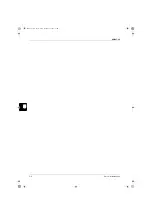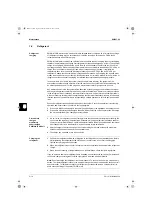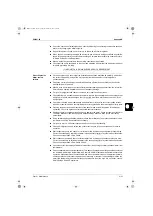
Appendix B
ESIE07-05
6–20
3
1
5
6
2.2
General Chiller Start-up Guide
Introduction
Detailed procedures will vary from chiller to chiller, but this guide is intended to indicate the principle
items to be checked on any Daikin chiller to ensure that the commissioning process is adequate. It is
not exhaustive and could be added to if necessary, particularly where optional accessories are
included. Whilst all chillers are run at the factory, this is only a brief functional test and it does not
remove the need for all relevant commissioning checks to be carried out.
(he procedures are in approximate chronological order.
Air cooled chillers
■
Once delivered to site, ensure that the installation instructions are followed carefully: particularly
the correct lifting and moving of the unit, spacing from walls and other chillers, pipework
connections etc.
■
Check the correct positioning of anti-vibration mounts (if fitted) and check that any devices for
transportation are removed.
■
Make a close visual inspection of the chiller for transport damage and general condition. Inform the
Service Department at Daikin Europe of any problems.
■
Carry out a refrigerant leak check of the whole unit, report and fix any leaks.
■
Check that there is a suitable strainer in the water-pipes to the evaporator, that the pipes are
purged of air and that at no time does the water flow exceed 120% of the design figure.
■
Check that the main power cables have been installed correctly, with the correct phase rotation,
with no mechanical strain on the terminals and correctly glanded in the electrical panel entry plate.
■
Opening the power and control sections of the panel, make a visual inspection for damage or
omissions. Check the tightness of all accessible cable terminations.
■
Remove the main compressor fuses and apply power to the panel. Check functioning of the Carel
controller. Make any required changes to default settings. Make a written record of all set-up
parameters.
■
Using calibrated gauges and thermometer, check the calibration of all pressure transducers and
temperature sensors. Re-calibrate as necessary.
■
Carry out a ‘dry run’ of the start sequence and check correct functionality.
■
Check all refrigerant service valves and ensure that they are in the correct position for normal
operation
■
Start evaporator pump and check for correct water flow by measuring evaporator pressure drop.
Correct as necessary by throttling the water in the evaporator outlet or by other means if available.
Check correct operation of flow switch.
■
Check evaporator water inlet temperature. If it is above the maximum catalogue value ensure that
the ‘soft-load’ and/or ‘high temperature start’ and/or EXV MOP features are enabled to ensure safe
operation. If these features are not available, and it is not possible to reduce the water temperature,
either operate the compressor capacity control manually or consider the possibility to reduce the
water flow temporarily to ensure that the suction pressure is not too high. If in any doubt, consult
the Daikin Europe Service Department.
■
Replace main fuses and, if oil heaters have been on long enough to establish superheat in the oil
separator, start circuit 1, leaving the other circuit(s) manually switched off.
■
Observe operating conditions, in particular, suction and discharge superheats, liquid subcooling
and evaporator and condenser approach temperatures. Adjust refrigerant charge, and/or control
settings, as necessary.
■
Check correct operation of compressor capacity control, expansion valve operation, condenser fan
control plus other optional devices.
■
Ensure that all condenser fans are rotating in the correct direction. Most units do not have dividers
between fans and so the only way to be sure that all fans are rotating correctly is to check them
visually. Make sure that this is done in a safe way.
ESIE07-05.book Page 20 Friday, December 21, 2007 3:21 PM







































